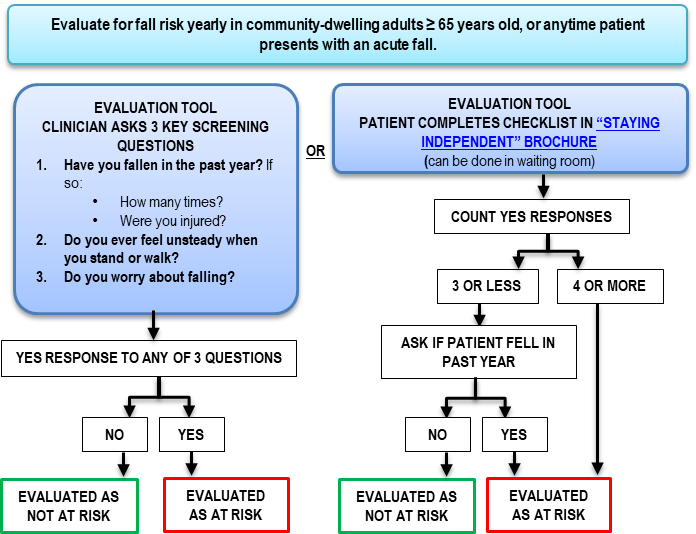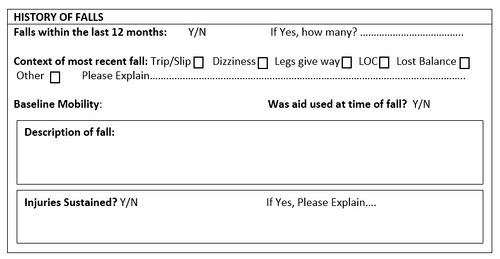The Main Principles Of Dementia Fall Risk
Wiki Article
Dementia Fall Risk Fundamentals Explained
Table of ContentsIndicators on Dementia Fall Risk You Should KnowLittle Known Facts About Dementia Fall Risk.Dementia Fall Risk for Dummies10 Simple Techniques For Dementia Fall Risk
An autumn threat analysis checks to see just how likely it is that you will certainly drop. It is mainly done for older adults. The assessment generally includes: This consists of a collection of inquiries regarding your general health and wellness and if you've had previous drops or problems with equilibrium, standing, and/or strolling. These tools test your toughness, equilibrium, and stride (the method you walk).STEADI consists of testing, evaluating, and treatment. Interventions are recommendations that may lower your risk of falling. STEADI consists of 3 steps: you for your threat of succumbing to your danger variables that can be boosted to attempt to protect against drops (for instance, equilibrium issues, impaired vision) to lower your danger of falling by using reliable methods (for instance, giving education and learning and sources), you may be asked a number of inquiries consisting of: Have you dropped in the past year? Do you feel unsteady when standing or walking? Are you fretted regarding dropping?, your company will certainly test your strength, balance, and gait, making use of the adhering to autumn analysis devices: This test checks your gait.
If it takes you 12 secs or even more, it may suggest you are at greater danger for a loss. This examination checks stamina and equilibrium.
Move one foot halfway onward, so the instep is touching the large toe of your various other foot. Relocate one foot totally in front of the other, so the toes are touching the heel of your other foot.
The Best Guide To Dementia Fall Risk
Many drops happen as an outcome of multiple adding factors; for that reason, handling the risk of falling starts with identifying the aspects that add to drop risk - Dementia Fall Risk. A few of the most pertinent threat variables consist of: History of prior fallsChronic clinical conditionsAcute illnessImpaired stride and balance, lower extremity weaknessCognitive impairmentChanges in visionCertain risky medications and polypharmacyEnvironmental variables can additionally increase the risk for falls, including: Poor lightingUneven or damaged flooringWet or unsafe floorsMissing or harmed handrails and grab barsDamaged or improperly equipped equipment, such as beds, wheelchairs, or walkersImproper usage of assistive devicesInadequate supervision of individuals staying in the NF, consisting of those who show aggressive behaviorsA successful loss danger monitoring program requires a comprehensive professional evaluation, with input from all members of the interdisciplinary team

The care plan must also consist of treatments that are system-based, such as those that promote a secure environment (appropriate lighting, handrails, get hold of bars, etc). The efficiency of the interventions should be examined occasionally, and the care click now plan revised as required to show modifications in the autumn threat analysis. Implementing an autumn threat administration system using evidence-based finest practice can decrease the frequency of falls in the NF, while limiting the capacity for fall-related injuries.
Dementia Fall Risk - Truths
The AGS/BGS guideline recommends screening all adults matured 65 years and older for autumn danger each year. This testing includes asking individuals whether they have actually fallen 2 or even more times in the previous year or looked for medical interest for a fall, or, if they have not dropped, whether they really feel unstable when strolling.Individuals who have dropped when without injury ought to have their balance and stride reviewed; those with stride or balance problems ought to receive extra evaluation. A background of 1 loss without injury and without gait or balance problems does not necessitate additional assessment past ongoing annual fall risk testing. Dementia Fall Risk. A loss threat assessment is required as component of the Welcome to Medicare exam

More About Dementia Fall Risk
Documenting a falls background is one of the top quality indications for fall avoidance and management. Psychoactive medicines in particular are independent forecasters of drops.Postural hypotension can commonly be minimized by reducing the dosage of blood pressurelowering medicines and/or quiting medications that have orthostatic hypotension as a negative effects. Use above-the-knee support tube and copulating the head of the bed elevated might likewise lower postural reductions in high blood pressure. The suggested aspects of a fall-focused checkup are revealed in Box 1.

A Pull time higher find this than or equal to 12 secs recommends high loss threat. Being incapable to stand up from a chair of knee elevation without using one's arms indicates increased autumn risk.
Report this wiki page